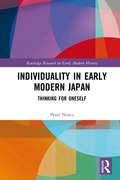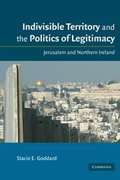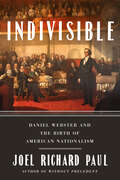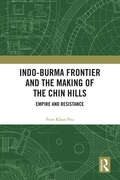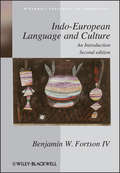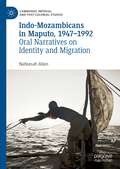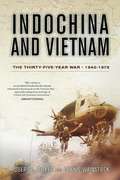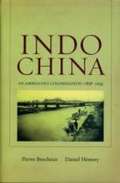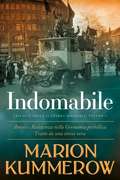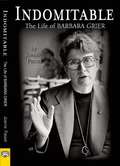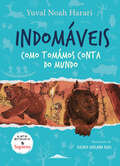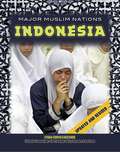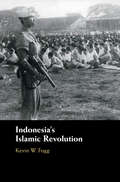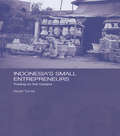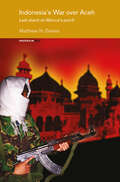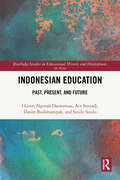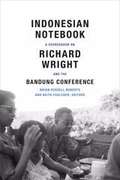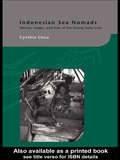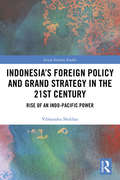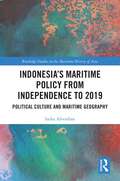- Table View
- List View
Individuality and Modernity in Berlin
by Moritz FöllmerMoritz Föllmer traces the history of individuality in Berlin from the late 1920s to the construction of the Berlin Wall in August 1961. The demand to be recognised as an individual was central to metropolitan society, as were the spectres of risk, isolation and loss of agency. This was true under all five regimes of the period, through economic depression, war, occupation and reconstruction. The quest for individuality could put democracy under pressure, as in the Weimar years, and could be satisfied by a dictatorship, as was the case in the Third Reich. It was only in the course of the 1950s, when liberal democracy was able to offer superior opportunities for consumerism, that individuality finally claimed the mantle. Individuality and Modernity in Berlin proposes a fresh perspective on twentieth-century Berlin that will engage readers with an interest in the German metropolis as well as European urban history more broadly.
Individuality in Early Modern Japan: Thinking for Oneself
by Peter NoscoTwo of the most commonly alleged features of Japanese society are its homogeneity and its encouragement of conformity, as represented by the saying that the nail that sticks up gets pounded. This volume’s primary goal is to challenge these and a number of other long-standing assumptions regarding Tokugawa (1600-1868) society, and thereby to open a dialogue regarding the relationship between the Japan of two centuries ago and the present. The volume’s central chapters concentrate on six aspects of Tokugawa society: the construction of individual identity, aggressive pursuit of self-interest, defiant practice of forbidden religious traditions, interest in self-cultivation and personal betterment, understandings of happiness and well-being, and embrace of "neglected" counter-ideological values. The author argues that when taken together, these point to far higher degrees of individuality in early modern Japan than has heretofore been acknowledged, and in an Afterword the author briefly examines how these indicators of individuality in early modern Japan are faring in contemporary Japan at the time of writing.
Indivisible Territory and the Politics of Legitimacy
by Stacie E. GoddardIn Jerusalem and Northern Ireland, territorial disputes have often seemed indivisible, unable to be solved through negotiation, and prone to violence and war.
Indivisible: Daniel Webster and the Birth of American Nationalism
by Joel Richard PaulThe story of how Daniel Webster popularized the ideals of American nationalism that helped forge our nation&’s identity and inspire Abraham Lincoln to preserve the Union When the United States was founded in 1776, its citizens didn&’t think of themselves as &“Americans.&” They were New Yorkers or Virginians or Pennsylvanians. It was decades later that the seeds of American nationalism—identifying with one&’s own nation and supporting its broader interests—began to take root. But what kind of nationalism should Americans embrace? The state-focused and racist nationalism of Thomas Jefferson and Andrew Jackson? Or the belief that the U.S. Constitution made all Americans one nation, indivisible, which Daniel Webster and others espoused? In Indivisible, historian and law professor Joel Richard Paul tells the fascinating story of how Webster, a young New Hampshire attorney turned politician, rose to national prominence through his powerful oratory and unwavering belief in the United States and captured the national imagination. In his speeches, on the floors of the House and Senate, in court, and as Secretary of State, Webster argued that the Constitution was not a compact made by states but an expression of the will of all Americans. As the greatest orator of his age, Webster saw his speeches and writings published widely, and his stirring rhetoric convinced Americans to see themselves differently, as a nation bound together by a government of laws, not parochial interests. As these ideas took root, they influenced future leaders, among them Abraham Lincoln, who drew on them to hold the nation together during the Civil War. As he did in Without Precedent and Unlikely Allies, Joel Richard Paul has written in Indivisible both a compelling history and a fascinating account of one of the founders of our national perspective.
Indo-Burma Frontier and the Making of the Chin Hills: Empire and Resistance
by Pum Khan PauThis book examines the British colonial expansion in the so-called unadministered hill tracts of the Indo-Burma frontier and the change of colonial policy from non-intervention to intervention. The book begins with the end of the First Anglo-Burmese War (1824–26), which resulted in the British annexation of the North-Eastern Frontier of Bengal and the extension of its sway over the Arakan and Manipur frontiers, and closes with the separation of Burma from India in 1937. The volume documents the resistance of the indigenous hill peoples to colonial penetration; administrative policies such as disarmament; subjugation of the local chiefs under a colonial legal framework and its impact; standardisation of ‘Chin’ as an ethnic category for the fragmented tribes and sub-tribes; and the creation and consolidation of the Chin Hills District as a political entity to provide an extensive account of British relations with the indigenous Chin/Zo community from 1824 to 1935. By situating these within the larger context of British imperial policy, the book makes a critical analysis of the British approach towards the Indo-Burma frontier. With its coverage of key archival sources and literature, this book will interest scholars and researchers in modern Indian history, military history, colonial history, British history, South Asian history and Southeast Asian history.
Indo-European Language and Culture: An Introduction (Blackwell Textbooks in Linguistics #30)
by Benjamin W. Fortson IVThis revised and expanded edition provides a comprehensive overview of comparative Indo-European linguistics and the branches of the Indo-European language family, covering both linguistic and cultural material. Now offering even greater coverage than the first edition, it is the definitive introduction to the field. Updated, corrected, and expanded edition, containing new illustrations of selected texts and inscriptions, and text samples with translations and etymological commentary Extensively covers individual histories of both ancient and modern languages of the Indo-European family Provides an overview of Proto-Indo-European culture, society, and language Designed for use in courses, with exercises and suggestions for further reading included in each chapter Includes maps, a glossary, a bibliography, and comprehensive word and subject indexes
Indo-European Sacred Space: Vedic and Roman Cult
by Roger D. WoodardIn Indo-European Sacred Space, Roger D. Woodard provides a careful examination of the sacred spaces of ancient Rome, finding them remarkably consistent with older Indo-European religious practices as described in the Vedas of ancient India. Employing and expanding on the fundamental methods of Émile Benveniste, as well as Georges Dumézil's tripartite analysis of Proto-Indo-European society, Woodard clarifies not only the spatial dynamics of the archaic Roman cult but, stemming from that, an unexpected clarification of several obscure issues in the study of Roman religion. Looking closely at the organization of Roman religious activity, especially as regards sacrifices, festivals, and the hierarchy of priests, Woodard sheds new light on issues including the presence of the god Terminus in Jupiter's Capitoline temple, the nature of the Roman suovetaurilia, the Ambarvalia and its relationship to the rites of the Fratres Arvales, and the identification of the "Sabine" god Semo Sancus. Perhaps most significantly, this work also presents a novel and persuasive resolution to the long standing problem of "agrarian Mars."
Indo-Mozambicans in Maputo, 1947-1992: Oral Narratives on Identity and Migration (Cambridge Imperial and Post-Colonial Studies)
by Nafeesah AllenThis book explores the experiences of ‘Indo-Mozambicans,’ citizens and residents of Mozambique who can trace their origins to the Indian subcontinent, a region affected by competing colonialisms during the twentieth century. Drawing from ethnographic interviews, the author illustrates why migration developed as both an identity marker and a survival tool for Indo-Mozambicans living in Maputo, in response to the series of independence movements and prolonged period of geo-political uncertainty that extended from 1947 to 1992. A unique examination of post-colonialism, the book argues that four pivotal moments in history forced migratory patterns and ethnic identity formations to emerge among Indo-Mozambicans, namely, the end of the British empire in India and the subsequent partition of India and Pakistan in 1947; the end of the Portuguese empire in India, with the annexation of Goa, Daman and Diu in 1961; the independence of Mozambique from Portugal in 1975; and the civil war of Mozambique from 1977 to 1992. Framing these historical markers as trigger points for shifts in migration and identity formation, this book demonstrates the layered experiences of people subject to Portuguese colonialism and highlights the important perspective of those ‘left behind’ in migration studies.
Indochina and Vietnam
by Robert Miller Dennis D. WainstockThe Indochina and Vietnam Wars followed one another over thirty-five years, from 1940 to 1975, yet these two closely related conflicts are usually treated separately. This book seeks to tell the story of those wars as a single historical event. Within days of France's defeat by Nazi Germany and Japan's military expansion into Southeast Asia in July 1940, the United States became involved in Indochina. Most histories quickly mention the colonial past, usually limited to the battle of Dien Bien Phu, to concentrate exclusively on the American war. A selection of published sources explains the context and the development of the long war while providing an overview of France's imprint on Indochina and Vietnam.The question "Why were we in Vietnam?" comes up regularly regarding the root causes for the ultimate deployment of over five hundred thousand US troops, most of them conscripts, into a virtually unknown land. When France left Indochina in 1954 it became an American problem. Weeks before the murder of John F. Kennedy came the overthrow of Ngo Dinh Diem and the escalation of the war in 1965-68. Finally, Richard Nixon, after extending the war into Cambodia, enacted both the Vietnamization process and negotiations in Paris between Henry Kissinger and Le Duc Tho, until the final act in April 1975, when the US embassy rooftop with the last helicopter taking off was flashed around the world as the grand finale to the war.
Indochina and Vietnam
by Robert Miller Dennis D. WainstockThe Indochina and Vietnam Wars followed one another over thirty-five years, from 1940 to 1975, yet these two closely related conflicts are usually treated separately. This book seeks to tell the story of those wars as a single historical event. Within days of France's defeat by Nazi Germany and Japan's military expansion into Southeast Asia in July 1940, the United States became involved in Indochina. Most histories quickly mention the colonial past, usually limited to the battle of Dien Bien Phu, to concentrate exclusively on the American war. A selection of published sources explains the context and the development of the long war while providing an overview of France's imprint on Indochina and Vietnam.The question "Why were we in Vietnam?" comes up regularly regarding the root causes for the ultimate deployment of over five hundred thousand US troops, most of them conscripts, into a virtually unknown land. When France left Indochina in 1954 it became an American problem. Weeks before the murder of John F. Kennedy came the overthrow of Ngo Dinh Diem and the escalation of the war in 1965-68. Finally, Richard Nixon, after extending the war into Cambodia, enacted both the Vietnamization process and negotiations in Paris between Henry Kissinger and Le Duc Tho, until the final act in April 1975, when the US embassy rooftop with the last helicopter taking off was flashed around the world as the grand finale to the war.
Indochina: An Ambiguous Colonization, 1858-1954
by Pierre Brocheux Daniel HémeryCombining new approaches with a groundbreaking historical synthesis, this accessible work is the most thorough and up-to-date general history of French Indochina available in English. Unique in its wide-ranging attention to economic, social, intellectual, and cultural dimensions, it is the first book to treat Indochina's entire history from its inception in Cochinchina in 1858 to its crumbling at Dien Bien Ph in 1954 and on to decolonization. Basing their account on original research as well as on the most recent scholarship, Pierre Brocheux and Daniel Hemery tell this story from a perspective that is neither Eurocentric nor nationalistic but that carefully considers the positions of both the colonizers and the colonized. With this approach, they are able to move beyond descriptive history into a rich exploration of the ambiguities and complexities of the French colonial period in Indochina. Rich in themes and ideas, their account also sheds new light on the national histories of the emerging nation-states of Vietnam, Laos, and Cambodia, making this book essential reading for students, scholars, and general readers interested in the region, in the Vietnam War, or in French imperialism, among other topics.
Indomabile: Trilogia della Seconda Guerra Mondiale, Volume 1
by Marion KummerowBerlino, Germania 1932. In un periodo di tensioni e conflitti politici, un uomo trova il coraggio di battersi… Il Dottor Wilhelm "Q” Quedlin, ingegnere chimico e inventore, vive per la scienza. Una donna non rientra nei suoi programmi e tantomeno essere accusato di spionaggio industriale. Le cose tuttavia prendono una brutta piega. Osservare l’ascesa di Hitler al potere non fa che accrescere il suo desiderio di evitare un’altra guerra che distruggerebbe completamente il suo amato paese. Q prende coscientemente la decisione di combattere contro ciò che sa essere sbagliato, anche se opporsi ai nazisti potrebbe significare morte certa per lui e per chi ama. Hilde Dremmer aveva giurato che non avrebbe più amato. Tuttavia, dopo avere incontrato Q, vuole dare all’amore una seconda possibilità. Quando Q le rivela il suo piano di resistenza, sta a Hilde scegliere tra la sua vita tranquilla senza di lui, oppure la costante minaccia di tortura qualora lo avesse sostenuto nella sua battaglia contro le ingiustizie. Lei ha già assistito a un numero sufficiente di atti violenti del governo nazista, tanto da essere atterrita dal nuovo potere politico, ma ciò sarà sufficiente perché una ragazza comune si comporti in modo straordinario e resti vicino all’uomo che ama in un momento di totale desolazione? Questa spy story al tempo della Seconda Guerra Mondiale si basa sugli eventi reali che videro una coppia combattere per la propria felicità e al contempo lottare contro i propri governanti.
Indomable heredero (Los Preston #Volumen 1)
by Julianne MayCinco hermanos. Una herencia. Una nueva vida en Londres. Leopold Preston detesta Londres, a los nobles y todo lo que ellos representan. Sin embargo, una trágica noticia lo obliga a viajar a aquella ciudad para asumir sus nuevas responsabilidades como barón. Josephine Hamilton, una joven más del montón, se encuentra entre la espada y la pared. La ambición de su padre atenta contra su felicidad, y aunque huir la haría perder la reputación, no encuentra otra salida. La unión de sus destinos parece impensable hasta que una noche y un inesperado acuerdo entre las familias los enredan en la decisión más difícil de sus vidas.
Indomitable: The Life of Barbara Grier
by Joanne Passet"Whatever else will be said about her--and you can bet there will be plenty, because Barbara was no stranger to controversy--the one thing that is true above all else is that she was the most important person in lesbian publishing in the world. Without her boldness and her audacity, there might not be the robust lesbian publishing industry there is today. ” --Teresa DeCrescenzo Barbara Grier--feminist, activist, publisher, and archivist--was many things to different people. Perhaps most well known as one of the founders of Naiad Press, Barbara’s unapologetic drive to make sure that lesbians everywhere had access to books with stories that reflected their lives in positive ways was legendary. Barbara changed the lives of thousands of women in her lifetime. For the first time, historian Joanne Passet uncovers the controversial and often polarizing life of this firebrand editor and publisher with new and never before published letters, interviews, and other personal material from Grier’s own papers. Passet takes readers behind the scenes of The Ladder, offering a rare window onto the isolated and bereft lives lesbians experienced before the feminist movement and during the earliest days of gay political organizing. Through extensive letters between Grier and her friend novelist Jane Rule, Passet offers a virtual diary of this dramatic and repressive era. Passet also looks at Grier’s infamous "theft” of The Ladder’s mailing list, which in turn allowed her to launch and promote Naiad Press, the groundbreaking women’s publishing company she founded with partner Donna McBride in 1973. Naiad went on to become one of the leaders in gay and lesbian book publishing and for years helped sustain lesbian and feminist bookstores--and readers--across the country. JOANNE PASSET is Professor of History Emerita at Indiana University East. Her previous books include Sex Variant Woman: The Life of Jeannette Howard Foster, Sex Radicals and the Quest for Women's Equality, Cultural Crusaders: Women Librarians in the American West, and Aspirations and Mentoring in an Academic Environment (with Mary Niles Maack).
Indomáveis 1: Como Tomámos Conta do Mundo
by Yuval Noah HarariSabias que tens um superpoder? Queres saber qual? Este livro conta-te tudo! Como é que o fogo influenciou a evolução dos nossos estômagos? Sim, leste bem. Estômagos! O que é que o futebol nos diz sobre ser humano? Porque é que o dinheiro é o conto de fadas mais bem-sucedido de sempre? E o que é que isso tudo tem que ver com o facto de sermos a espécie dominante na Terra? Nesta primeira fantástica aventura da série Indomáveis, Yuval Noah Harari revela-te os segredos das origens da humanidade, como nunca antes te contaram. Como tomámos conta do mundo? A resposta está numa das histórias mais fascinantes que alguma vez irás ler!
Indonesia
by Lynda Cohen CassanosIndonesia is an archipelago that includes more than 17,000 islands and stretches across three time zones. It is home to the world's largest Muslim population-more than 200 million Indonesians follow the faith. In 1998 Indonesians replaced the rule of a dictator with democracy, and since then the country has held free and open elections for president as well as for members of a national assembly. However, Indonesia is not without problems, particularly poverty and corruption. There is an armed separatist movement in Aceh, and Islamist terrorist groups like al-Qaeda have targeted Westerners on Bali. This book examines the economic and political issues facing Indonesia today. It provides up-to-date information about the country's geography and climate, history, society, important cities and communities, and relations with other countries
Indonesia's Islamic Revolution
by Kevin W. FoggThe history of the Indonesian Revolution has been dominated by depictions of grassroots fighters and elite politicians who thought of it as a nationalistic or class-based war. In this major new study, Kevin W. Fogg rethinks the Indonesian Revolution (1945–49) as an Islamic struggle, in which pious Muslims, who made up almost half the population, fought and organized in religious ways. Muslims fighting on the ground were convinced by their leaders' proclamations that they were fighting for a holy cause. In the political sphere, however, national leaders failed to write Islam into Indonesia's founding documents - but did create revolutionary precedents that continue to impact the country to this day. This study of a war of decolonization in the world's most populous Muslim country points to the ways in which Islam has functioned as a revolutionary ideology in the modern era.
Indonesia's Small Entrepreneurs: Trading on the Margins
by Sarah TurnerIn the context of Makassar, on the eastern Indonesian island of Sulawesi, the book explores the socioeconomic and cultural relationships that make life for small entrepreneurs in Makassar so distinctive. Using a new framework for the study of small enterprises - the 'small enterprise integrative framework' - this book gives us a greater understanding of the organization and operations of small enterprises in developing countries, at both the micro and macro levels. The application of this new framework for research reveals the diversity of labour flexibility, networking and cluster styles amongst the enterprises studies, and the constraints they face for growth. Whilst the recent Southeast Asian economic crisis has been heralded by certain commentators as a new era for small enterprises in the region, the book concludes that local realities for the small enterprises in Makassar mean that, whilst for some it has been a time of shifting fortunes, others have continued trading on the margins.
Indonesia's War over Aceh: Last Stand on Mecca's Porch (Politics in Asia)
by Matt DaviesSince 2001, Indonesia’s military commitment to Aceh province resulted in one of Southeast Asia’s largest wars for decades. Indonesia's War over Aceh presents the background and history of this war, investigating its domestic and international implications, at a time when the recent tsunami catastrophe has brought Aceh to world attention. Using military doctrinal references and extensive, original research, Davies reconstructs reported events, combatant forces, terminology and statistical data to expose many of the war’s sensitive issues. He challenges others’ preceding research by detailing the Indonesian military’s mission, structures, combat strains, and activity within political, operational and paramilitary realms. Drawing on Indonesian-Malay sources normally unseen by the English-speaking world, Indonesia's War over Aceh will be essential reading for regional specialists and those interested in contemporary conflict.
Indonesian Education: Past, Present, and Future (Routledge Studies in Educational History and Development in Asia)
by I Gusti Darmawan Ace Suryadi Dasim Budimansyah Susilo SusiloOffering an overview of the history, perspectives, and developments of education in Indonesia since the country’s independence in 1945, in this book, the authors raise awareness of education's impact on national development in this unique context.With more than 50 million students, 3 million teachers, and 300,000 schools, Indonesia's most significant challenge for education is not only to improve access but also to improve the education quality to face the fast-paced world we live in today. The book traces the development of Indonesian education since 1945, highlighting its successes, failures, and responses to social, political, and economic changes. It addresses key issues such as legislation, school systems, education management, national policies, quality versus expansion, equity, curriculum, assessment, and unemployment. This book offers a nuanced understanding of the history of education in Indonesia and serves as a comparative reference for studies with other countries.The book will be a valuable resource for researchers, students, and scholars of comparative education, educational history, and Asian studies.
Indonesian Notebook: A Sourcebook on Richard Wright and the Bandung Conference
by Brian Russell Roberts Keith FoulcherWhile Richard Wright's account of the 1955 Bandung Conference in The Color Curtain has been key to shaping Afro-Asian historical narratives, Indonesian accounts of Wright and his conference attendance have been largely overlooked. Indonesian Notebook contains myriad documents by Indonesian writers, intellectuals, and reporters, as well as a newly recovered lecture by Wright, previously published only in Indonesian. Brian Russell Roberts and Keith Foulcher introduce and contextualize these documents with extensive background information and analysis, showcasing the heterogeneity of postcolonial modernity and underscoring the need to consider non-English language perspectives in transnational cultural exchanges. This collection of primary sources and scholarly histories is a crucial companion volume to Wright'sThe Color Curtain.
Indonesian Sea Nomads: Money, Magic and Fear of the Orang Suku Laut
by Cynthia ChouThe Orang Suku Laut consider themselves indigenous Malays. Yet their interaction with others who call themselves Malays is characterised on both sides by fear of harmful magic and witchcraft. The nomadic Orang Suku Laut believe that the Qur'an contains elements of black magic, while the settled Malays consider the nomads dangerous, dirty and backward. At the centre of this study, based on first-hand anthropological data, is the symbolism of money and the powerful influence it has on social relationships within the Riau archipelago. The first major publication on these maritime nomadic communities, the book also adds fresh perspectives on anthropological debates on exchange systems, tribality and hierarchy. It also characterises the different ways of being Malay in the region and challenges the prevailing tendency to equate Malay identity with the Islamic faith.
Indonesia’s Foreign Policy and Grand Strategy in the 21st Century: Rise of an Indo-Pacific Power (Asian Security Studies)
by Vibhanshu ShekharThis book examines the changes in Indonesian foreign policy during the 21st century as it seeks to position itself as a great power in the Indo-Pacific region. The rise of 21st-century Indonesia is becoming a permanent fixture in both the domestic and global discourses. Though there has been an increasing level of discussion on Indonesia’s emerging power status, there has been little discussion on how the country is debating and signalling its new-found status. This book combines the insights of both neo-classical realism and social identity theory to discuss a reset in an emerging Indonesia’s foreign policy during the 21st century while emphasizing domestic drivers and constraints of its international behaviour. There are three key organizing components of the book – emerging power, status signalling and the Indo-Pacific region. The Indo-Pacific region constitutes a spatial framing of the book; the emerging power provides an analytical category to explain Indonesia’s changing international status; and status signalling explains multiple facets of international behaviour through which the country is projecting its new status. Though leaders are adding different styles and characteristics to the rising Indonesia narrative, there are a few unmistakable overarching trends that highlight an increasing correlation between the country’s rising power and growing ambition in international behaviour. This book is built around four key signalling strategies of Indonesia as an emerging power – expanded regional canvas, power projection, leadership projection, and quest for great power parity. They represent Indonesia’s growing desire for a status-consistent behaviour, its response to the prevailing strategic uncertainty in the Indo-Pacific region and its attempt to advance its strategic interests. This book will be of much interest to students of South-East Asian politics, strategic studies, international diplomacy, security studies and IR in general.
Indonesia’s Maritime Policy from Independence to 2019: Political Culture and Maritime Geography (Routledge Studies in the Maritime History of Asia)
by Indra AlverdianAlverdian explores how a distinct national character of maritime governance has influenced the nature of Indonesia's aspiration to go beyond archipelagic towards a maritime nation, through focusing on the intersection between the nation's political culture, historical changes and geopolitical contexts, which gave rise to the primacy of the theme of unity in the nation's discourse.The main theme of this research is the three-pillar framework of the Tanah-Air concept, which includes the political culture of persatuan nasional (national unity), the strategic culture of cakra manggilingan (turning of the times from dark to golden periods), and the geopolitical context of posisi silang dunia (world crossroad position). The findings of this publication indicate the dominant influence of Javanese political culture, philosophy, values, and traditions on the distinct character of Indonesia’s maritime orientation. Specifically, Javanese political philosophy and traditions within each pillar of Tanah-Air have influenced continuity rather than change in the evolution of Indonesia’s maritime policy. This book helps readers understand how the defining theme of unity in national political culture has shaped the evolution of Indonesia’s maritime policy from 1945 to 2019. It illustrates how the continuous influence of the theme of national unity as devised by the political elites through history has addressed the realities of the archipelago’s geography, and it is significant from both an academic and practical policy perspective.A book designed for academics and the general public interested in gaining greater insight and knowledge on Indonesia’s maritime policy and maritime nation aspirations.
Indoor America: The Interior Landscape of Postwar Suburbia (Midcentury: Architecture, Landscape, Urbanism, and Design)
by Andrea VesentiniCars, single-family houses, fallout shelters, air-conditioned malls—these are only some of the many interiors making up the landscape of American suburbia. Indoor America explores the history of suburbanization through the emergence of such spaces in the postwar years, examining their design, use, and representation. By drawing on a wealth of examples ranging from the built environment to popular culture and film, Andrea Vesentini shows how suburban interiors were devised as a continuous cultural landscape of interconnected and self-sufficient escape capsules. The relocation of most everyday practices into indoor spaces has often been overlooked by suburban historiography; Indoor America uncovers this latent history and contrasts it with the dominant reading of suburbanization as pursuit of open space. Americans did not just flee the city by getting out of it—they did so also by getting inside. Vesentini chronicles this inner-directed flight by describing three separate stages. The encapsulation of the automobile fostered the nuclear segregation of the family from the social fabric and served as a blueprint for all other interiors. Introverted design increasingly turned the focus of the house inward. Finally, through interiorization, the exterior was incorporated into the all-encompassing interior landscape of enclosed malls and projects for indoor cities. In a journey that features tailfin cars and World’s Fair model homes, Richard Neutra’s glass walls and sitcom picture windows, Victor Gruen’s Southdale Center and the Minnesota Experimental City, Indoor America takes the reader into the heart and viscera of America’s urban sprawl.

